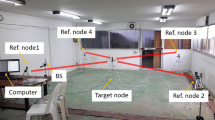Abstract
A new position location technique is proposed, using received signal strength measurements, which can be implemented using inexpensive off-the-shelf equipment. The proposed technique is based on geometric loci construction, and overcomes the need for onsite calibration measurements or propagation prediction tools and topographical/architectural plans of the covered area. The proposed algorithm exhibits similar simulated performance compared to a recently proposed positioning technique, but without the need of model calibration. In addition, measurements results are also presented, demonstrating the performance of the algorithm.
Similar content being viewed by others
References
FCC acts to promote competition and public safety in enhanced wireless 911 services, FCC, Washington, DC, WT Rep. 99-27, Sep. 15. (1999).
COMMISSION RECOMMENDATION of 25 July 2003, on the processing of caller location information in electronic communication networks for the purpose of location-enhanced emergency call services., Official Journal of the European Union, July 27 (2003).
Sayed A. H., Tarighat A., Khajehnouri N. (2005) Network-based wireless location. IEEE Signal Processing Magazine 22(4): 24–40
Raya, M., & Hubaux, J. P. (2005). The security of vehicular ad-hoc networks. In: Proceedings of the 3rd ACM workshop on security of ad-hoc and sensor networks (pp. 11–21), Alexandria, VA, USA.
Raya, M., Papadimitratos, P., & Hubaux, J. P. (2006). Securing vehicular communications. In: IEEE Wireless Communications (pp. 8–15), October 2006.
Parno, B., & Perrig, A. (2005). Challenges in securing vehicular networks. In: Proceedings of the 4th workshop on hot topics in networks (pp. 1–6), College Park, MD, November 14–15, 2005.
Liberti J., Rappaport T. S. (1999) Smart antennas for wireless communications: IS-95 and third generation CDMA application. Prentice Hall PTR, New Jersey
Caffery J. L., Stüber G. L. (1998) Overview of radiolocation in CDMA cellular systems. IEEE Communications Magazine 36(4): 38–45
Liu B. C., Lin K. H., Wu J. C. (2006) Analysis of hyperbolic and circular positioning algorithms using stationary signal-strength difference measurements in wireless communications. IEEE Transactions on Vehicular Technology 55(2): 499–509
Bahl, P., & Padmanabhan, V. N. (2000). RADAR: An in-building RF-based user location and tracking system. In Proceedings of the 19th annual joint conference of the IEEE computer and communications societies (Vol. 2, pp. 775–784).
Youssef, M. A., Agrawala, A., & Shankar, A. U. (2003). WLAN location determination via clustering and probability distributions. In Proceedings of the 1st IEEE international conference on pervasive computing and communications (pp. 143–150).
Youssef, M., & Agrawala, A. (2003). Small-scale compensation for WLAN location determination systems. In IEEE wireless communications and networking conference 2003 (Vol. 3, pp. 1974–1978).
Prasithsangaree, P., Krishnamurthy, P., & Chrysanthis, P. K. (2000). On indoor position location with wireless LANS. In The 13th IEEE international symposium on personal, indoor and mobile radio communications (Vol. 2, pp. 720–724).
Kaemarungsi, K., & Krishnamurthy, P. (2004). Modeling of indoor positionings systems based on location fingerprinting. In Proceedings of the 23rd annual joint conference of the IEEE computer and communications societies (Vol. 2, pp. 1012–1022).
Mazuelas S., Bahillo A., Lorenzo R.M., Fernandez P., Lago F.A., Garcia E. et al (2009) Robust indoor positioning provided by real-time RSSI values in unmodified WLAN networks. IEEE Journal of Selected Topics in Signal Processing 3(5): 821–831
Hellebrandt M., Mathar R., Scheibenbogen M. (1997) Estimating position and velocity of mobiles in a cellular radio network. IEEE Transactions on Vehicular Technology 6(1): 65–71
Hellebrandt M., Mathar R. (1999) Location tracking of mobiles in cellular radio networks. IEEE Transactions on Vehicular Technology 48(5): 1558–1562
Collmann R. R. (2001) Evaluation of methods for determining the mobile traffic distribution in cellular radio networks. IEEE Transactions on Vehicular Technology 50(6): 1629–1635
Weiss A. J. (2003) On the accuracy of a cellular location system based on RSS measurements. IEEE Transactions on Vehicular Technology 52(6): 1508–1518
Catrein, D., Hellebrandt, M., Mathar, R., & Serrano, M. P. (2004). Location tracking of mobiles: a smart filtering method and its use in practice. In Proceedings of the IEEE 59th vehicular technology conference (Vol. 5, pp. 2677–2681).
Locus, Wolfram Mathworld, available online at http://mathworld.wolfram.com/Locus.html .
Pahlavan K., Levesque A. H. (1995) Wireless information networks. John Wiley and Sons, New York
Rappaport T. S. (1996) Wireless communications—Principles and practice. Prentice Hall PTR, New Jersey
Stuber G. L. (2001) Mobile communication. Kluwer Academic Publishers, Norwell
Linksys. (2003). WAP11 Wireless-B Access Point—Technical Specifications.
Cisco. (2004). Aironet 350 Series Client Adapters Datasheet.
NetStumbler. (2004). Network Detection Tool v.0.4.0 Release Notes.
Agilent. (2005). ESA Series Spectrum Analyzers Datasheet.
Author information
Authors and Affiliations
Corresponding author
Rights and permissions
About this article
Cite this article
Mitilineos, S.A. Blind Position Location via Geometric Loci Construction. Wireless Pers Commun 60, 665–677 (2011). https://doi.org/10.1007/s11277-010-9966-y
Published:
Issue Date:
DOI: https://doi.org/10.1007/s11277-010-9966-y




